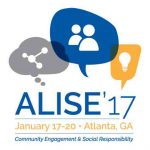I revised our YouthStudio participatory research & design model using feedback from my colleague Martin Wolske at UIUC. I added a few steps to highlight what Martin and I agree represent some of the potential transformative and social change aspects of our approach, which include the following: information –> knowledge, knowledge –> action, and action –> power processes. All of this is what I believe to be an extension of our Community Informatics Studio.
 (Click on image above to enlarge)
(Click on image above to enlarge)
In my thinking, this perspective is also informed by Randy Stoecker’s (2014) re-conceptualization of the civic engagement goals within many higher ed community-engagement projects, an approach which he lays out nicely in his paper, “What If?”
The excerpt below highlights my thinking about how the evaluative and critical reflective aspects of the YouthStudio design cycle have the potential to lead to what Stocker refers to as “knowledge power” in the paper.
When I think about knowledge development as civic engagement, however, I need to do so from the standpoint of the constituency, not the university, and that requires some shifts in my thinking about knowledge. One perspective that has been helpful to me in making these shifts has come from Michel Foucault (1975; 1980) and his thinking about power/knowledge. My understanding of this idea is that power and knowledge are mutually reinforcing. When someone has power, they are in a better position to produce knowledge that will in turn enhance their power. For me, power is the ability to engage in goal-directed action. And knowledge is not simply information, but information that has been sifted and sorted and critiqued and organized in a way that facilitates power. I then use the phrase knowledge power to refer to the capacity to gather information and use it to develop knowledge that can effectively inform goal-directed action. My job in higher education civic engagement is to work with constituencies to help them build their collective knowledge power. (p. 1666)
In other words, when our model includes the phrase “action –> power,” it is perhaps more accurate to say that we’re making the assumption that action — which is embodied by the design activities as well as the evaluation of and critical reflection on how the design activities speak to the “hypothesis” or design problem (as in the action-research-design model above) — will lead to greater knowledge power for youth who participate in the YouthStudio project.
The next step, I believe, is to begin to pull together our various theoretical and methodological approaches in order to articulate an evaluation framework that simultaneously encompasses, builds upon, and extends our critical interpretive contributions to date.
References
Stoecker, R. (2014). What if? AISHE-J: The All Ireland Journal of Teaching and Learning in Higher Education, 6(1), 1661-16616.
 I’m giving a talk tomorrow here at the Association for Library and Information Science Education conference during the session, titled “Community Engagement and Social Responsibility: Frameworks for Pedagogy and Praxis.” The title of my presentation is “YouthStudio: Promoting Just and Equitable Community Engagement in LIS” (link to PDF).
I’m giving a talk tomorrow here at the Association for Library and Information Science Education conference during the session, titled “Community Engagement and Social Responsibility: Frameworks for Pedagogy and Praxis.” The title of my presentation is “YouthStudio: Promoting Just and Equitable Community Engagement in LIS” (link to PDF).
